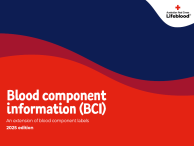Don’t have an account?
Select the donation type you’d like to make
Blood components must be stored at the appropriate temperature as shown in the following tables.
Failure to follow correct storage requirements may result in decreased transfusion efficacy, potential harm to the patient or the component being unsuitable for use and discarded.
Red cells
| Storage temperature | Shelf life | Comments |
|---|---|---|
| 2–6 ºC | Red cells: 42 days | All blood refrigerators, including theatre and other holding refrigerators, must comply with AS 3864.1, AS 3864.2 (1, 2) |
| Paediatric red cells: 35 days | ||
| Washed red cells: 28 days |
Platelets
| Storage temperature | Shelf life | Comments |
|---|---|---|
| 20–24 ºC | 7 days | Platelet components must be agitated gently and continuously in a single layer on a platelet agitator. |
Fresh frozen plasma (FFP), cryodepleted plasma, cryoprecipitate
| Storage temperature | Shelf life | Comments |
|---|---|---|
| At or below –25 ºC | 12 months | Freezers must comply with AS 3864.1 & 3864.2 (1,2). |
Fractionated plasma products
| Storage temperature | Shelf life | Comments |
|---|---|---|
| As per product insert | As per expiry date on product | All blood refrigerators, including theatre and other holding refrigerators must comply with AS 3864.1, AS 3864.2 (1, 2) |
Key points
-
Keep handling of refrigerated components outside of refrigeration to a minimum to ensure that maximum temperature requirements are not exceeded.
-
Red cell components must not exceed 30 minutes at room temperature on each occasion.
-
Maintain components in a controlled temperature environment until administered.
-
Handle and store components in a way that minimises the possibility of product tampering.
-
Alarm set points should be set within 0.5 ºC of the storage temperature range.




